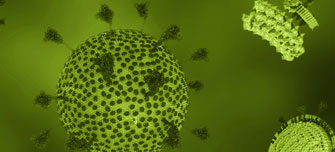Keeping up with virus taxonomy: viruses spread by vectors
Posted on October 19, 2022 by Charlotte Hartley
The ‘Keeping up with Virus Taxonomy’ blog series returns! In the first post of the renewed series, we look at a range of viruses that are spread by vectors.
Rhabdoviridae
From the Ancient Greek word for rod (rhabdos), rhabdoviruses are usually bullet- or rod-shaped and enclosed in an envelope. The family is made up of three subfamilies: Alpharhabdovirinae, Betarhabdovirinae and Gammarhabdovirinae.
Rhabdoviruses infect a wide range of plants and animals, including mammals, birds, reptiles, amphibians and fish. Famously, the rabies virus (Rabies lyssavirus) is transmitted by saliva and infects the central nervous system of its animal host. Rhabdoviruses also infect insects, which may serve as hosts themselves or act as vectors to transmit the virus to other animals or plants. For example, a number of plant pathogens including lettuce necrotic yellows virus and strawberry crinkle cytorhabdovirus are carried by aphid vectors. Meanwhile, vesicular stomatitis virus is transmitted to cattle and livestock by biting flies or midges.
Geminiviridae
Geminiviruses are also transmitted by insect vectors and infect a range of plants. This family encodes its genetic information in a single-stranded, circular, DNA genome. Some geminiviruses have DNA satellites (large arrays of repeating, non-coding DNA).
The Geminiviridae family includes some economically important plant pathogens, which cause diseases in tropical and sub-tropical regions across the world. For example, maize streak virus is transmitted by various leafhopper insect species and causes crop failure in sub-Saharan Africa and the islands of the Indian Ocean.
Potyviridae
Comprising nearly a third of all known plant viruses, potyvirus infections are of great agricultural significance throughout the globe. These flexuous, filamentous viruses have single-stranded, RNA genomes contained within a core capsid protein.
The largest genus in the Potyviridae family is Potyvirus, which has 183 known species. These viruses are carried by aphid vectors and infect many agricultural and horticultural plants such as potatoes, asparagus, bananas, carrots, irises, lilies and sunflowers.
Nairoviridae
Nairoviruses are spherical and enveloped, with surface spikes. Genetic information is encoded in three single-stranded RNA segments. The family contains seven genera and 15 species.
The name Nairoviridae is derived from Nairobi sheep disease, a tick-borne infection caused by one of its members, Orthonairovirus. This disease affects sheep and goats across Africa and India. Other members of the Nairoviridae family are also transmitted by tick vectors to mammals or birds. For example, Crimean-Congo haemorrhagic fever virus can cause severe symptoms and often death when humans are bitten by an infected tick.
Nyamiviridae
Named as a portmanteau of Nyamanini Pan in South Africa (nya), where the member species Nyamanini virus was isolated, and Midway Atoll in the US (mi), where the Midway virus was isolated, Nyamiviridae is a family of RNA viruses with a spherical shape and envelope.
These viruses have been found to be associated with a diverse range of invertebrates, from nematode worms to moths to crustaceans. Infected ticks may also serve as vectors. Some nyamiviruses infect birds; for example, members of the genus Nyavirus have been discovered in egrets, gulls and herons.
The International Committee on Taxonomy of Viruses (ICTV) is responsible for developing and maintaining a universal virus taxonomy. Known viruses are categorised into a classification scheme taking into consideration their physical and biological properties in combination with their phylogenetic relationships.
These two-page summaries of each chapter of the ICTV Report (a free resource published by the ICTV which provides an up-to-date description of virus taxonomy) are freely available in the Journal of General Virology, and are supported by the Microbiology Society. These summaries are known as ICTV Virus Taxonomy Profiles and describe the structure, replication and taxonomy of each virus order and family.

